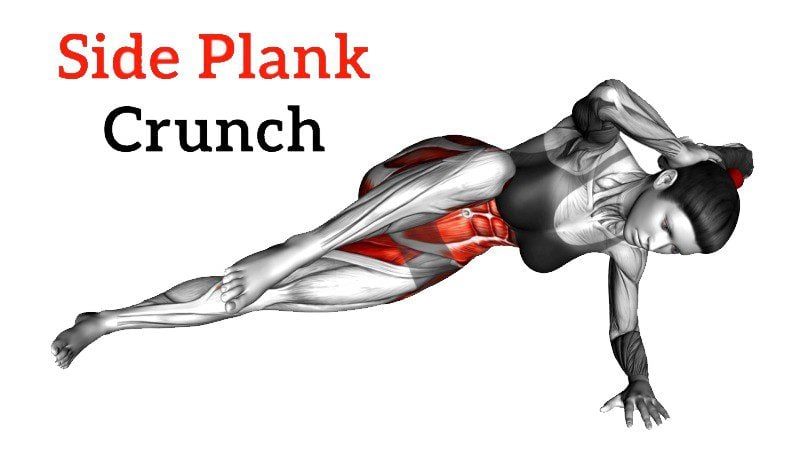The Side plank crunch, also known as the elbow-to-knee side plank crunch, is a great exercise for building strength and stability of core muscles.
It combines your standard crunches with side plank exercise into one move that will challenge your balance, tone up your waist, and strengthen your core.
Side plank crunch works your whole body by combining all the core actions you get from a traditional plank with extra love for your shoulders and hips. This exercise hits your obliques doubly hard.
It’s an excellent upgrade on the traditional plank for targeting hard-to-reach core muscles, specifically, the external obliques and serratus anterior.
To Lose Fat, Know Your Fat Lose Calories Requirements

Side Plank Crunch Muscles Worked
The Side plank crunch engages a wide range of major muscle groups.
- The primary muscles worked during side plan crunches are the obliques, abs, and back muscles, including the erector spinae and the transverse abdominus.
- In addition, the position uses the Serratus Anterior, lateral deltoids, and Trapezius of the upper body, as well as the gluteus maximus and hip flexors.
How to Do Side Plank Crunch
- Get in a side plank position by lying on your left side on the floor with your right foot resting on top of the inner side of your left foot.
- Place your right hand behind your head. Keep your torso stable and your hips lifted.
- Now, bring your right leg up toward your right shoulder to lightly tap your right elbow with your knee.
- Lengthen your left leg back to the starting position to complete one rep.
- Continue for a set amount of time or reps, and then repeat on the other side.
Note: The exercise starts with 10 repetitions and can be increased to 20 repetitions or more as needed.
Know More: 18 Abs Exercises You Can Do at Home Without Equipment
Tips and Technique
Just like with any exercise, certain safety precautions should be followed when performing this exercise.
- If you want to do this exercise without the risk of injury, make sure you have enough space.
- Make sure you do this exercise on a flat surface so that it doesn’t hurt your knees or back.
- Don’t let your hips drop or rotate—the movement should come from your core.
- Avoid letting your hips sag during the exercise.
- Squeeze your abs and glutes throughout the movement for stability.
- Breathe steadily; exhale as you crunch; inhale as you return to the starting position.
Side Plank Crunches Modifications
If you have not done the plank crunch on your own before, take it slow and follow the experts’ tips below. Remember, perfecting any exercise, especially one that requires strength and full-body balance, takes some time.
- To make it easier, keep your knees on the ground instead of fully stretching your legs. Start with shorter holds and fewer repetitions.
- To make it harder, place your feet on a stability ball or hold a dumbbell or weight plate to your top hip.
Benefits
- When you do side plank crunch exercises, you work all the muscles in your core. The upper and lower body muscles are strengthened.
- The side plank helps prevent muscle imbalances. When muscles are evenly developed on both sides of the body, the result is better posture, increased spinal support, and reduced lower-back pain.
- It helps improve functional movement, which is essential for living a full life. Things such as squatting, bending, running, lifting, jumping, and throwing are all functional movements initiated in the core.
- It is a combination of strength and cardiovascular exercise. These plank variations can help you burn calories and regulate your weight.
References
- Gottschall JS, et al. (2013). Integration core exercises elicit greater muscle activation than isolation exercises. DOI:
http://doi.org/10.1519/JSC.0b013e31825c2cc7 - Tvrdy, Douglas PT, DPT, CSCS. The Reverse Side Plank/Bridge: An Alternate Exercise for Core Training. Strength and Conditioning Journal 34(2):p 86-88, April 2012.

Manish is a NASM-certified fitness and nutrition coach with over 10 years of experience in weight lifting and fat loss fitness coaching. He specializes in gym-based training and has a lot of knowledge about exercise, lifting technique, biomechanics, and more.
Through “Fit Life Regime,” he generously shares the insights he’s gained over a decade in the field. His goal is to equip others with the knowledge to start their own fitness journey.
